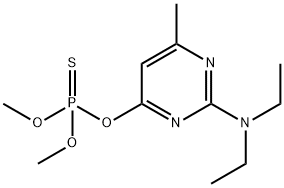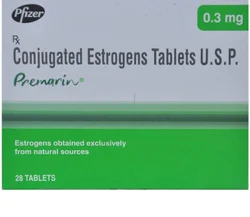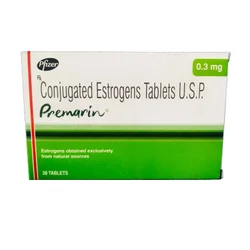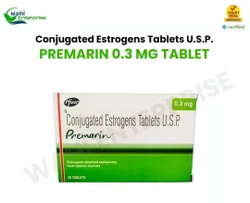Premarin
- CAS NO.:12126-59-9
- Empirical Formula: C18H19NaO5S
- Molecular Weight: 370.4
- MDL number: MFCD00240712
- EINECS: 235-199-5
- SAFETY DATA SHEET (SDS)
- Update Date: 2025-07-04 15:29:35

What is Premarin?
Absorption
The conjugated estrogens are well absorbed in the gastrointestinal tract and the maximum plasma concentration of the conjugated estrogens is reached after 7 hours depending on the estrone component. The maximal plasma concentration of conjugated estrogens after multiple doses of 0.45 mg is reported to be of 2.6 ng/ml with an AUC in the steady state of 35 ng.h/ml. Unconjugated estrogens are known to be cleared from the circulation at a faster rate than their ester forms.
Toxicity
The reported oral LD50 in the rat is of more than 5000 mg/kg. Serious overdosage symptoms have not been reported. There have been only reports of nausea, vomiting, and withdrawal in bleeding in females.
Long-term continuous administration of estrogens is correlated to increased risk on the incidence of carcinomas of the breast, uterus, cervix, vagina, testis, and liver.
Description
Conjugated estrogens generally occur as butter-colored powders that are soluble in water. The sodiumequilin sulfate component is unstable to light and air.Piperazine estrone sulfate occurs as a white to yellowishwhite crystalline powder that is slightly soluble in water.Piperazine estrone sulfate melts at 245℃ with decomposition. Conjugated estrogens are naturally occurring substances excreted in the urine of pregnant mares; piperazineestrone sulfate is not known to occur naturally.
Chemical properties
Almost white or brownish, amorphous powder.
Chemical properties
Conjugated estrogens generally occur as butter-colored powders
The Uses of Premarin
Estrogen
The Uses of Premarin
Conjugated Estrogen is a mixture of estrogen derivatives-mostly estrone and equilin sulfate.
What are the applications of Application
Conjugated Estrogen is a mixture of estrogen derivatives-mostly estrone and equilin sulfate
Background
The conjugated estrogens are noncrystalline mixtures of purified female sex hormones obtained either by its isolation from the urine of pregnant mares or by synthetic generation from vegetal material. Both of these products are later conjugated to natrium sulfate by ester bonds in order to make them more water soluble.
The conjugated estrogen product contains a mix of estrogen from which about 50% is represented by estrone sulfate followed by 25% of equilin sulfate, 15% of 17-alpha-dehydroequilenin sulfate, 3% of equilenin sulfate, 5% of 17-alpha and 17-beta-dihydroequilenin sulfate, 2% of 17-alpha-estradiolsulfate and 3% of 17-beta-estradiolsulfate. It also presents a large number of unidentified molecules with weak estrogenic activity as well as non-human molecules when it is obtained from pregnant mares urine.
The conjugated estrogen mixture was approved for marketing in US in 1942 based on the efficacy against certain conditions. However, until 1986 official clinical trials were performed and this product was determined to be effective for the treatment of osteoporosis. The currently approved product of conjugated estrogens was developed by Wyeth Ayerst and FDA approved in 2003.
Indications
The conjugated estrogens are indicated for several different conditions including:
Definition
ChEBI: Equilin sodium sulfate is a steroid sulfate. It is functionally related to an equilin.
Pharmacokinetics
The binding of estrogens to the estrogen receptor produces the activation of nuclear receptors in order to bind to estrogen response elements in certain target genes. This mechanistic cascade results in histone acetylation, alteration of chromatin conformation and the initiation of transcription of certain specific drugs.
In preclinical studies, the conjugated estrogens are known to have a similar estrogenic potency than estrone and the equilin components of the conjugated estrogens have similar potency in the liver when compared to bioidentical estradiol. It has also been tested and confirmed that conjugated estrogens present a selective estrogen receptor modulator profile which allows it to have a large beneficial effect on the bone and cardiovascular system.
Clinically, the administration of conjugated estrogens is known to promote vasomotor stability, maintain genitourinary function, and normal growth and development of female sex hormones. It has also been shown to prevent accelerated bone loss by inhibiting bone resorption and restoring the balance of bone resorption. In the hormonal area, it is shown to inhibit luteinizing hormone and decrease the serum concentration of testosterone.
Safety Profile
Suspected human carcinogen producing tumors of the vascular system and liver. Human reproductive effects: changes in female fertility. When heated to decomposition it emits toxic fumes of NazO. See also indvidual components.
Potential Exposure
Conjugated estrogens are naturally occurring substances excreted in the urine of pregnant mares; piperazine estrone sulfate is not known to occur naturally. Conjugated estrogens are used to treat symptoms of the climacteric, vulvae dystrophies; female hypogonadism; and dysfunctional uterine bleeding. They also are used for treatment following: ovariectomy, for chemotherapy of mammary cancer and prostate carcinogema; and for prevention of postpartum breast engorgement. In addition, conjugated estrogens have been found in cosmetic preparations
First aid
If this chemical gets into the eyes, remove anycontact lenses at once and irrigate immediately for at least15 min, occasionally lifting upper and lower lids. Seek medical attention immediately. If this chemical contacts theskin, remove contaminated clothing and wash immediatelywith soap and water. Seek medical attention immediately. Ifthis chemical has been inhaled, remove from exposure,begin rescue breathing (using universal precautions, including resuscitation mask) if breathing has stopped and CPR ifheart action has stopped. Transfer promptly to a medicalfacility. When this chemical has been swallowed, get medical attention. Give large quantities of water and inducevomiting. Do not make an unconscious person vomit.
Metabolism
The conjugated estrogens are metabolized by a number of different pathways. One of the metabolic pathways of the conjugated estrogens is driven by the action of the cytochrome isoenzyme CYP3A4. On the other hand, the conjugated estrogens can also be processed by a dynamic equilibrium of metabolic interconversion and sulfate conjugation. Some of the principal metabolic reactions of the conjugated estrogens are driven by the conversion of 17beta-estradiol to estrone and the further change to estriol. A portion of the administered conjugated estrogens will remain in the blood as sulfate conjugates which serve as a circulating reservoir for the generation of new estrogens.
In the endometrium, equilin is metabolized to 2-hydroxy and 4-hydroxy equilin as well as 2-hydroxy and 4-hydroxy estradiol. This hydroxylation process is very large in various of the components of the conjugated estrogens and hence, the major metabolites in urine are known to be 17-ketosteroid-16-alpha-hydroxy estrone, 16-alpha-hydroxy-17-beta-dihydro equilin and 16-alpha-hydroxy-17-beta-dihydroequilenin.
Storage
Color Code—Blue: Health Hazard/Poison: Storein a secure poison location. Prior to working with thischemical you should be trained on its proper handling andstorage. A regulated, marked area should be establishedwhere this chemical is handled, used, or stored in compliance with OSHA Standard 1910.1045.
Shipping
UN3077 Environmentally hazardous substances, solid, n.o.s., Hazard class: 9; Labels: 9-Miscellaneous hazardous material, Technical Name Required. UN3249 Medicine, solid, toxic, n.o.s., Hazard Class: 6.1; Labels: 6.1-Poisonous materials. PGIII.
Incompatibilities
Estrogens are Incompatible with oxidizers (chlorates, nitrates, peroxides, permanganates, perchlorates, chlorine, bromine, fluorine, etc.); contact may cause fires or explosions. Keep away from alkaline materials, strong bases, strong acids, oxoacids, epoxides, acid chlorides, and acid anhydrides.
Waste Disposal
It is inappropriate and possibly dangerous to the environment to dispose of expired or waste drugs and pharmaceuticals by flushing them down the toilet or discarding them to the trash. Household quantities of expired or waste pharmaceuticals may be mixed with wet cat litter or coffee grounds, double-bagged in plastic, discard in trash. Larger quantities shall carefully take into consideration applicable DEA, EPA, and FDA regulations. If possible return the pharmaceutical to the manufacturer for proper disposal being careful to properly label and securely package the material. Alternatively, the waste pharmaceutical shall be labeled, securely packaged, and transported by a state licensed medical waste contractor to dispose by burial in a licensed hazardous or toxic waste landfill or incinerator
Properties of Premarin
| CAS DataBase Reference | 12126-59-9(CAS DataBase Reference) |
Safety information for Premarin
Computed Descriptors for Premarin
New Products
4,4-Difluoropiperidine hydrochloride tert-butyl 9-methoxy-3-azaspiro[5.5]undecane-3-carboxylate Indole Methyl Resin N-Isopropylurea N,N-Dicyclohexylcarbodiimide(DCC) MELDRUMS ACID 5-METHYLISOXAZOLE-4-CARBOXYLIC ACID Magnessium Bis glycinate Zinc ascorbate 1-bromo-2-butyne 2-acetamidophenol 9(10H)-anthracenone Erythrosin B, 4-Piperidinopiperidine 2-((4-morpholinophenylamino) (methylthio) methylene) malononitrile 2,4-dihydroxybenzaldehyde 3-(4-morpholinophenylamino)-5-amino-1H-pyrazole-4-carbonitrile Methyl 2-methylquinoline-6-carboxylate 2,6-dichloro-4-nitropyridine 4-Bromo-2-chlorobenzonitrile 2-(benzylamino)acetic acid hydrochloride 4-(tert-Butoxycarbonylamino)but- 2-ynoic acid 3,4-dihydro-2H-benzo[b][1,4]dioxepine 1-Phenyl-1-cycloprppanecarboxylicacidRelated products of tetrahydrofuran








You may like
-
 12126-59-9 Conjugated estrogen 98%View Details
12126-59-9 Conjugated estrogen 98%View Details
12126-59-9 -
 Conjugated estrogen 98%View Details
Conjugated estrogen 98%View Details
12126-59-9 -
 Conjugated Estrogens CAS 12126-59-9View Details
Conjugated Estrogens CAS 12126-59-9View Details
12126-59-9 -
 Premarin 0.3 Mg tabletView Details
Premarin 0.3 Mg tabletView Details
12126-59-9 -
 Premarin 0.3 Mg tabletView Details
Premarin 0.3 Mg tabletView Details
12126-59-9 -
 Premarin 0.3mg Tablet - Conjugated Estrogens 0.3mgView Details
Premarin 0.3mg Tablet - Conjugated Estrogens 0.3mgView Details
12126-59-9 -
 Premarin 0.3 Mg tabletView Details
Premarin 0.3 Mg tabletView Details
12126-59-9 -
 20677-73-0 (2,2-diethoxyethyl)methylamine 98%View Details
20677-73-0 (2,2-diethoxyethyl)methylamine 98%View Details
20677-73-0
